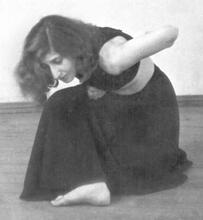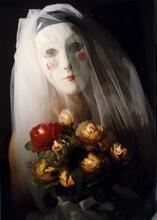Rina Yerushalmi
Theater director and choreographer Rina Yerushalmi, one of Israel’s leading artists, is the founder and artistic director of the experimental Itim Theater Ensemble. After serving in the Israeli Defense Force she moved to London, where she learned the Laban technique and studied stage management. Her vision was to create a theater laboratory dedicated to the research and performance of classical texts in contemporary theater. In each of her projects she aims to reflect and touch life in the present by examining the flux and changing dynamics between actors, audiences, and familiar texts. Her unique theatrical language is based on visual images that present the classical texts in a new light, making them acute and relevant by means of expressive movement, music, and lighting.
Theatrical Career
Theater director and choreographer Rina Yerushalmi, one of Israel’s leading artists, is the founder and artistic director of the experimental Itim Theater Ensemble (founded 1989). Her vision was to create a theater laboratory dedicated to the research and performance of classical texts in contemporary theater. In each of her projects she aims to reflect and touch life in the present by examining the flux and changing dynamics between actors, audiences and the familiar texts. All of the Ensemble’s productions are based on Yerushalmi’s adaptations of canonical plays or non-dramatic texts. The performances grow out of long periods of intensive work with the team of actors, sometimes devoting over a year of training and rehearsals to one project. Her aesthetic concentrates on the diversity and multiplicity of events at any given moment and the interplay between them. In each of her projects, she constructs new relations between time, space, characters, and actors, thus creating innovative compositions that do not necessarily emphasize the traditional centrality of the text. Her techniques include the free use of doubling and tripling of characters (three different actresses playing the role of Juliet in Romeo and Juliet [1992], or three simultaneous Clytemnestras in Mythos [2002]); re-editing scenes of the original texts (placing the scene of the Creation of the World as a sequence after the destruction caused by Noah’s Flood in Va-Yomer/Va-Yelech [1996]); juxtaposing famous scenes with unexpected visual images (David and Goliath as a clown fighting a giant woman on crutches in Va-Yishtahu/Va-Yera, 1998); and giving one character’s lines to another, thus altering traditional perspectives. Her unique theatrical language is based on visual images that present the classical texts in a new light, making them acute and relevant by means of expressive movement, music, and lighting.
Yerushalmi’s theatrical career started long before she formed the Itim Ensemble. She was born on March 1, 1939, in the northern Israeli town of Afulah, to Saul Yerushalmi (originally Yerusalimski, 1904–1984) and Haya (Angilovich) Yerushalmi (1908–2000), and grew up in Haifa. Both her parents immigrated to Israel from Russia, her father from Odessa in 1917, and her mother from Lachovich in 1920. Her father was an engineer and her mother was a nurse. She has one older brother, Uri Yerushalmi (b. 1936). She started her dance training at the age of six, studying the Mary Wigman technique with Yardena Cohen and later the Martha Graham technique with Rina Gluck. After serving in the Israeli Defense Force she moved to London, where she learned the Laban technique at the Sigurd Leeder School of Dance (1959–1961) and studied stage management at the Royal Academy of Dramatic Art (1961–1962). Back in Israel she focused on studying and specializing in the Feldenkrais mind and body integration technique, which became a significant methodological resource for her theatrical philosophy and for the way she works with actors. She also studied the Lee Strasberg acting method with Nola Chilton before moving to the United States to study at the Carnegie Mellon University, Pittsburgh, where in 1970 she received her MFA degree in Theater Directing. Her final project, mentored by Professor Leon Katz, was an adaptation of Büchner’s Woyzeck. Moving to New York City, she joined Ellen Stewart’s experimental La Mama Theater, where she became a resident director (1972–1978). In 1972 she won a UNESCO fellowship to travel to Japan where she studied Noh and Kyogen theater with the renowned Yatoro Ohkura. This experience also had a great influence on the development of her aesthetic and performance ideology. On returning to Israel she founded and was artistic director of the Israeli branch of La Mama E.T.C., located in a bomb shelter in Tel Aviv (1972–1974).
The 1970s and 1980s
From 1970 to 1989 she divided her time between New York and Tel Aviv, teaching acting and movement classes at Carnegie Mellon University, New York University, The City College of the City University of New York (1980), Tel Aviv University, and Seminar ha-Kibbutzim in Tel Aviv (1984–1994). During this period she also continuously created and directed theater performances. Some of the most notable of these were her 1970 Toy Show, an adaptation of The Dybbuk by Leon Katz at La Mama E.T.C., New York; Garcia Lorca’s surrealist Chimera at La Mama, Tel Aviv in 1973, and her productions at the Haifa Theater, including her adaptation of Samuel Beckett’s novel Malone Dies (1978), Luigi Pirandello’s Six Characters in Search of an Author (1986) and Macbeth (1986). During this period she collaborated with stage designer Moshe Sternfeld (d. 1994) and conducted special workshops for Israeli actors on performing Shakespeare in Hebrew. In 1988 she directed Hamlet with a group of young actors who premiered the play at the Acre Alternative Theater Festival. When the performance moved to Tel Aviv it was performed in a rehearsal room at the Cameri Theater, eighty spectators at a time surrounding the actors and only a white circle on the floor demarcating the space of the action. In this production Hamlet’s confrontation with his father’s ghost was choreographed as an erotic encounter on the circumference of the white circle, echoing the biblical icon of Jacob’s wrestling with the angel. Yerushalmi’s Hamlet led to the foundation of the Itim Ensemble (in affiliation with the Cameri Theater, Tel Aviv) and won her the Israeli 1990 Margalit Award for Best Director and Best Production. It also paved the way to international recognition, her Hamlet invited to the International Shakespeare Festival in Braunschweig, where it was performed alongside productions by Peter Brook and Peter Stein. It was also performed in New York at BAM (Brooklyn Academy of Music) in 1992.
Later Career and Honors
In her next production, Woyzeck 91 (1991), she adapted the play in order to explore the theme of eugenics, depicting Woyzeck (played by Shuli Rand) as a victim of military and medical experiments. She added to the doctor’s lines (played by a cross-dressed actress, Dina Blei) medical texts about the anatomy of the human body, and placed the audience as spectators observing an operation in a sterile white room. In her 1993 Romeo and Juliet she examined the concept of “being in love” by creating repetitive and simultaneous images that capture the feeling of timelessness. This was the first Israeli production to appear at the International Shakespeare Festival in London, under the auspices of the Royal Shakespeare Company.
Following this, Yerushalmi received many more honors and awards, including the 1992 Ha-Levi award for Best Director of Woyzeck 91 and the 1999 Theater Academy Award for Best Theatrical Creation for her Bible project. This monumental and complex project—Va-Yomer/Va-Yelech (He Said/And Went), which was followed in 1998 by Va-Yishtahu/Va-Yera (They Bowed/And He Saw), an eight-hour-long epic performance based solely on selected and re-edited excerpts from the Hebrew Bible performed in the original ancient and poetic Hebrew. Perhaps Yerushalmi’s most innovative and political work, this performance is also her most Jewish one. Like all her works it examines characters, actions and social concepts from unexpected and shifting points of view. The story of the sacrifice of the Daughter of Jephtah, for example, was narrated by an actress whose movement and action gradually intensified, accompanied by the increasing volume of modern electronic music, emphasizing the perspective of the young daughter rather than the traditional viewpoint of the father.
By re-examining the Bible from a secular point of view, resisting any use of religious or cultural folklore, and creating contemporary images (the scene of the temptation was danced by the group of actors eating apples with forks and knives and evoking visual metaphors of sexual relationships) she explored the meanings and role of the Bible for Israeli society. Especially political was the second part of the project, Va-Yelech, which paralleled the biblical story of the Exodus from Egypt and the conquest of the land of Israel with the twentieth-century’s ordeals of the Jewish people. In an almost empty theatrical space, the actors in modern black dress evoked the imagery and iconography of the Holocaust, the founding of the State of Israel and the ongoing situation of war—all transmitted solely via the biblical texts. Following this project (which ran for over five years, and was invited to leading theaters and festivals around the world, including the London International Festival of Theater, the Berlin Theater Der Welt, the Adelaide Festival in Australia, the Hamburg Sommer Theater Festival, and the Wiener Festwochen in Vienna), Yerushalmi created Mythos (2002), an adaptation of nine Greek tragedies about the House of Atreus that deals with the theme of personal and national revenge. In this performance, the theatrical space is “never completed” but is composed of hundreds of wooden boards that denote an archeological search into the haunting memories of Electra and Orestes.
Yerushalmi currently serves as Professor of Theater at Tel Aviv University. In 2001 she was awarded an honorary doctorate from the Hebrew University of Jerusalem. In 2002, for the first time in her career, Rina Yerushalmi received a theater building for the Itim Ensemble from the Tel Aviv Municipality. Located on Nahmani Street in the heart of Tel Aviv, this space is where she works daily, rehearsing and developing new theatrical projects committed to the exploration and reflection of the symphonic, simultaneous and complex experience of life.
Selected Works by Rina Yerushalmi
Mythos, adaptation (2002).
Electra, opera (1999).
Va-Yishtahu/Va-Yera, Bible Project Part II (1998).
Va-Yomer/Va-Yelech, Bible Project Part I (1996).
Hedda Gabler (1994).
La Juive, opera (1993).
Romeo and Juliet, adaptation (1992).
Woyzeck 91, adaptation (1991).
Hansel and Gretel, opera (1990).
The Chairs (1990).
Hamlet, adaptation (1988).
Six Characters in Search of an Author (1986).
Macbeth (1986).
Malone Dies, adaptation (1978).
Shiffman, Galia. “Rina Yerushalmi: The Freedom to Act” (Hebrew). Iton 77 52 (1984): 64–67. Rozik, Eli. “A Sympathetic View: Rina Yerushalmi’s Woyzeck 91” (Hebrew). Bamah 135 (1994): 37–52. Idem. “Stage Metaphor: With or Without: On Rina Yerushalmi’s Production of Ionesco’s The Chairs.” Theater Research International 19:2 (1994): 148–155. Linda Ben-Zvi. “Interview with Rina Yerushalmi.” In Theater in Israel, edited by Linda Ben-Zvi, 373–382. Ann Arbor: 1996. Adi, Einat. “The Land She Shows us: A Conversation with Rina Yerushalmi” (Hebrew). Studio 90 (1998): 34–43. Aronson-Lehavi, Sharon. “Clues to Contemporary Israel in the Bible: A Theatrical Interpretation” (Hebrew). Ha-Teatron 1 (1998): 68–73.






